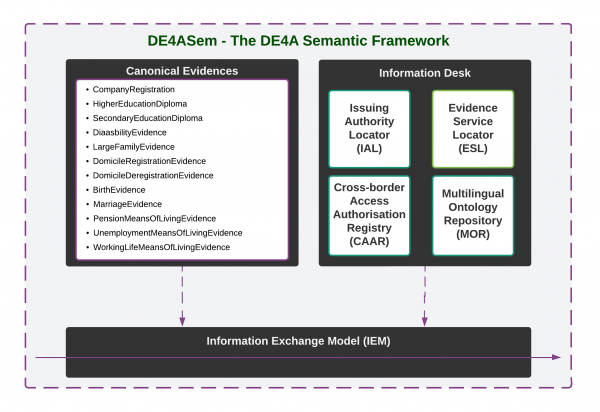DE4A Semantic interoperability
The framework and the semantic components of the semantic layer of the DE4A technical system is described in this wiki page and the subsequent pages.
| Component | Description | Piloted? |
|---|---|---|
| Canonical Evidence | Canonical Evidence is the canonical form of domestic evidence according to a common data structure and format. DE4A has defined a canonical form for each of the evidence types identified as relevant for the procedures involved in the cross-border evidence exchange of the DE4A pilots. | Yes |
| Canonical event | Event that has a common understanding of its meaning and triggers. They are grouped in catalogues and data owners offer cross-border Data Consumers to subscribe to them for receiving notifications when some event happens. | Yes |
| IAL | Issuing Authority Locator (IAL) component helps the Data Consumer (DC) to find out the issuing authority within a particular country either to obtain a canonical evidence or to subscribe to a canonical event catalogue, and know the characteristics of the provision. | Yes |
| ESL | Evidence Service Locator (ESL) helps the DC to obtain the technical details of the evidence service that corresponds to a provision located with the IAL | Yes |
| CAAR | Cross-border Access Authorisation Registry (CAAR) is the authorization register and controller that allows for checking access to specific provisions initiated by a specific DC for a specific purpose. | No |
| MOR | Multilingual Ontology Repository (MOR) provides the semantics and syntax of canonical evidence types, additional parameters of provisions, and code lists used, by defining them and the terms that compose them in a multilingual manner, with the aim to provide a common understanding of each canonical evidence type and multilingual graphical user interfaces for the explicit request, evidence preview and additional parameters functionalities. | Yes |
| IEM | The Information Exchange Model (IEM) provides the payload specification of the messages to be exchanged between competent authorities. | Yes |
According to the European Interoperability Framework,
Semantic interoperability ensures that the precise format and meaning of exchanged data and information is preserved and understood throughout exchanges between parties, in other words ‘what is sent is what is understood’. In the EIF, semantic interoperability covers both semantic and syntactic aspects:
- The semantic aspect refers to the meaning of data elements and the relationship between them. It includes developing vocabularies and schemata to describe data exchanges, and ensures that data elements are understood in the same way by all communicating parties;
- The syntactic aspect refers to describing the exact format of the information to be exchanged in terms of grammar and format.
In this sense, semantic interoperability agreements need to be set up and manage as part of the interoperability governance and the public service governance. In DE4A, there are concepts and information that need to have a common understanding and the semantic assets of the Information Desk (IDK) implement the corresponding semantic interoperability agreements. The main concepts of such agreements are:
- Canonical evidence type: canonical form for each evidence type that has been identified by the DE4A pilots as relevant for their online procedures. Each canonical evidence type has been designed in a collaborative way between the consuming and issuing authorities and the semantic experts in the DE4A. The full semantic description of the terms that compose each canonical evidence type is available trough the DE4A Multilingual Ontology Repository (MOR). Each canonical evidence type is identified by an URI according to the DE4A policy of identifiers.
- Canonical event catalogue: agreement for a group of events regarding an specific topic. Each canonical event catalogue is identified by an URI according to the DE4A policy of identifiers.
- Provision: availability of a data service provided by a issuing authority (data owner) for issuing a canonical evidence type (evidence provision) or subscribing to a canonical event catalogue (subscription provision). For the intermediation pattern, a provision can require some additional parameters for properly identity the data subject and the registry source of the evidence. Available provisions are located through the DE4A Issuing Authority Locator (IAL) by specifying at least a canonical evidence type or event catalogue and, optionally, an administrative territorial level or unit where the issuing authority has competences (national, regional, local or educational level or unit). The additional parameters, administrative levels and territorial units are semantically described in the DE4A Multilingual Ontology Repository.
- Data Service Endpoint: information for actually use the data service that corresponds to a provision. This information is available through the DE4A Evidence Service Locator (ESL), obtaining the data service endpoint information from a issuing authority (data owner) and a document type (either a canonical evidence type or a canonical event catalogue). Besides, the DE4A Information Exchange Model (IEM) implements the semantic agreement for the exchange of business messages through data services.
- MOR term: term uniquely identified and defined from the semantic and the syntactic point of view in MOR for a common understanding in every EU official language. Labels, descriptions and examples of a MOR term in each language are provided by an automatic translation from English to be verified or corrected by domain experts for each language. The data type of a term can be a simple type (e.g. string) or a complex type; complex types are composed by other simple and/or complex types. Each canonical evidence type, set of additional parameters for a provision and code list are complex types, as well as concepts of core vocabularies and ontologies that are reused for defining other complex types. The full semantic description of all the multilingual terms used in DE4A is available through the DE4A Multilingual Ontology Repository (MOR).
